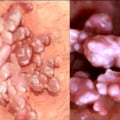HPV-related cancers usually take years to develop after an infection. Cervical cancer, the third most common type of cancer in women, usually takes 10 years or more to develop from the time of infection. In the United States, cervical cancer is much less common due to recommended routine Pap smears, which can detect cervical cancer before it turns into cancer. Cervical cancer starts in cells on the surface of the cervix, the lower part of the uterus.
There are two types of cells on the surface of the cervix: squamous and columnar. Most cervical cancers come from these squamous cells. Cancer usually starts very slowly as a condition called dysplasia. This precancerous condition can be detected by a Pap smear and is 100% treatable. If left undetected, precancerous changes can develop into cervical cancer and spread to other organs such as the bladder, intestines, lungs, and liver.
These precancerous changes can take years to develop into cervical cancer. However, patients with cervical cancer don't usually have problems until the cancer is advanced and has spread. Most of the time, early-stage cervical cancer has no symptoms. Symptoms of advanced cancer may include back pain, bone fractures, fatigue, heavy vaginal bleeding, urine leakage, leg pain, loss of appetite, and pelvic pain. If after a Pap smear, the doctor finds abnormal changes in the cervix, a colposcopy may be ordered. Using a low-powered light and microscope, the doctor will look at the cervix with a magnifying glass.
The doctor can remove pieces of tissue, called a biopsy, and send the sample to a laboratory for testing. If a woman is diagnosed with cervical cancer, the doctor will order more tests to determine how far the cancer has spread. Treatment will depend on the stage of the cancer, the size and shape of the tumor, the woman's age and general health, and her desire to have children in the future. Early-stage cervical cancer can be treated with surgery only to remove abnormal tissue, freeze abnormal cells, or burn abnormal tissue. Treatment for more advanced cervical cancer may include radical hysterectomy - removal of the uterus and much of the surrounding tissue including lymph nodes and upper part of vagina - radiation therapy or chemotherapy. Almost all cervical cancers are caused by human papillomavirus (HPV), a common virus spread through sexual intercourse.
HPV vaccines can prevent infection against two types of HPV responsible for approximately 70% of cervical cancers. Practicing safe sex also reduces risk of contracting HPV. However, keep in mind that most women diagnosed with cervical cancer haven't had regular Pap tests. Because Pap tests can detect precancerous tumors that are 100% treatable it's very important for women to have a Pap smear at regular intervals. If you don't treat an HPV infection it can cause cells inside cervix to turn into cancer; it can often take 10 to 30 years from time you become infected until tumor forms. Many people infected with HPV never get warts.
If warts develop they usually appear within few months but sometimes they show up years later. Most types of HPV cause common warts which can grow anywhere on body and are often found on hands and feet; they are contagious but don't cause cancer. Genital warts (condyloma acuminata) are clinical manifestations of sexually transmitted infection caused by some types of human papillomavirus (HPV). Genital HPV can infect any part of genital area including vulva inside vagina or penis; genital warts usually rise above surface of skin present parakeratosis and present nuclear changes typical of HPV infections (nuclear enlargement with perinuclear elimination).A large number of cases of genital warts do not respond to treatment and often recur especially with repeated infections caused by sexual contact or by long incubation period of HPV; couples should be examined by health care provider who can detect genital warts and test for other STDs. Types 16 and 18 cause approximately 70% of cervical cancers and types 6 and 11 cause approximately 90% of genital warts; DNA testing should not be used for diagnosis or for low-risk HPV infections; this activity describes evaluation and treatment of genital warts and explains role of interprofessional team in improving care for patients with this condition. Be sure to get screened for cancer of cervix vagina vulva or anus if you have been diagnosed with genital warts; genital warts are usually diagnosed visually although biopsy may be needed to confirm it.










